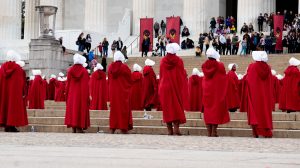Abolitionist Movement hosts Do What You Do Week
October 28, 2014
Eye-opening. Shocking. Heartbreaking. Enraging.
These are all words used by members of the Student Abolitionist Movement. Why? They’re describing a terrible reality that millions of people around the world are facing right this second: human trafficking.
“My freshman year, I had no idea what human trafficking was, and I saw a guy with a sign that said ‘Slavery Still Exists. 27 Million Enslaved’ and then I really just had no idea what that meant or what that was,” Claire Torell, president of SAM, said.
Misconception #1: Slavery doesn’t exist/It isn’t a domestic problem.
The goal of SAM is to create a conversation about the reality of human trafficking and to urge others to action. Since hearing about it nearly four years ago, SAM’s own president has worked closely with victims domestically and abroad, in Thailand and as close as Savannah.
“It puts a face with an issue,” Torell said. “When you see such huge numbers, you don’t understand that those are families, are people who look just like you. And when you see people bought and sold as products, it changes things.”
At the U.S. Department of Health and Human Service’s last count, there were nearly 17,500 people trafficked into the United States. Of that number, nearly 50 percent were children.
To make things even more unbelievable, Atlanta serves as one of the largest human trafficking centers in the world.
Misconception #2: It doesn’t affect me
Unless you or someone you know has been a victim of human trafficking, it’s likely you don’t think about it much on a daily basis.
“I knew about the child labor portion of it,” Vanessa Peterman, SAM’s vice president, said.
When shopping or even passing by other people, Peterman admits it’s hard not to become bitter. Why? Many brands engage in unethical practices that consumers directly benefit from.
However, purchasing products that have a Fair Trade symbol on it can help reduce your contribution to the trafficking institution.
Misconception #3: You can tell who’s involved
“Trafficking thrives in the darkness. We don’t see what people are doing, we see the products. You have to go looking for it to find the people,” Torell said.
Part of what makes human trafficking difficult to spot is its inclusive nature. Sex trafficking, forced labor and other commercial aspects all can fall under the term “human trafficking.”
For most, Torell says, it takes seeing to believe it. Unfortunately, it isn’t always easy to tell who is a victim of human trafficking. According to Vanessa Peterman, SAM’s vice president, the signs can be similar to those of a domestic abuse victim.
“They’re very closed, to themselves, shy to contact. Their lives are very constrained,” Peterman said. “It could be anyone, and that’s a scary thing. Anyone can be a victim and anyone can be perpetuating [human trafficking].”
Misconception #4: I can’t do anything to stop it
While it isn’t always possible to tell who is a victim or a perpetrator, there are ways for each person to help, regardless of your skill set or knowledge level.
SAM will be making its way down campus this week as part of its Do What You Do week. The week’s main goal is to help each person understand how they can help stop the transactions that perpetuate human trafficking – no matter their major, skill set, or interests.
“I’m an optimist. I like to think this can be fixed,” Heather Lana, public relations coordinator for SAM, said. “If I can stop one person from getting trafficked, then, perhaps, that person can stop someone else.”
Quick Info:
President: Claire Torrell
Fees: No
FB: /SAMGSU
Twitter: SAMatGSU
Meetings: RU 2040 Tuesdays at 7 p.m. every other week.
Do What You Do Week
When: 10 a.m. – 3 p.m.
Where:
Tuesday, Oct. 28
COBA and IT
Wednesday, Oct. 29
Carroll and Newton
Thursday, Oct. 30
Forest Drive, Health Services, & Counseling Center





